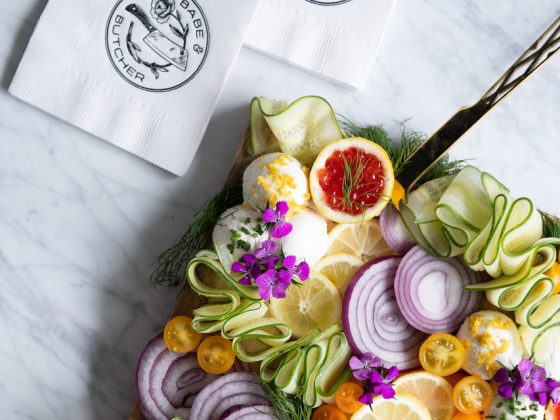Jerry Talton understands wood. A carver for many years now, he spends a good deal of his time in the shop. Run into him in his home of Carteret County, North Carolina, though, particularly between the months of September and January, and you’re likely to find him in a wholly different element: down by the water, patiently, quietly waiting for the telltale signs of waterfowl on the move. An onlooker—anyone unfamiliar with this flat land, its watermen, and its history—could be forgiven for a little confusion at the sight. There’s no reason to wait for anything to fly in, it seems, since there’s a whole flock floating right out there on the calm waters of the sound. But those aren’t real live ducks.
That’s a rig of old-school duck decoys, carved, constructed, painted, and weighted so that they look and act like ducks treading water. Like I said, the guy understands wood—particularly the lightweight, buoyant kind down around Carolina’s coastal plains. Jerry Talton carves these things, and he’s made quite a name for himself doing it. A couple years ago, he was Garden & Gun’s Made in the South winner for the outdoors category, as well as the magazine’s Artist in Residence at Palmetto Bluff last winter. These days, his whole life is centered around duck decoys. A bit of a celebrity in eastern NC, he’s also vice president of the Core Sound Decoy Carvers Guild. He’s a collector, too, of course: No lover of this particular craft, it seems, can keep fewer than a couple hundred or so relics around himself at any given time.
“My wife thinks it’s some kind of mental illness,” Jerry laughs.

And it may be, if obsession with those who came before us is a little crazy. That’s really what fuels this decoy-collecting world he’s found himself a part of, which is admittedly niche, but which also moves large sums of money. Mental illness or not, these things are highly sought after. Fortunately for his family, his own handmade, antiqued decoys, which are all crafted using the old techniques, are more than coveted.
“I used to make 25 to 30 decoys a year,” he says seriously. “Now, if I can make two a week, I’ll be busy for at least the next three years.”
The first time Jerry Talton got his hands on an antique decoy, he couldn’t put it down. It was a Christmas gift for his brother, but in the weeks leading up to the holiday season, that worn, old deke taught him a few things—first of all, that he could make one. Jerry used to shape surfboards, and “hell,” he thought, inspecting it, “this ain’t nothing but a surfboard with a duck’s head on it.” While I think he’s wrong about that—his birds will probably be in museums someday, and not because they resemble surfboards—he was right about his ability. And secondly, it seemed to have stories to tell. So he started looking for some of those stories in the waterfront community where he lives.
“When I wanted to learn how to carve,” Jerry recalls, “I knew where to go: Down East, North Carolina. In our area, everybody says ‘down east’ when they’re talking about Kinston and Goldsboro, but “Down East” is actually the proper name for the geographical area east of Beaufort.
Like any self-respecting coastal community, Carteret County is full of old timers—some of them fourth- and fifth-generation watermen—who know a hell of a lot more than anyone else. Of course, that doesn’t mean they’re always willing to share. So naturally the first decoy expert Jerry tried wasn’t too helpful… at first.
“He’d say, ‘You need to read this here book. After you read it and you think you know something about decoys, come back and talk to me.’ Well,” Jerry says, “I bought the damn book.”
Jerry’s next stop was a little decoy shop, where he bought his first bit of Atlantic white cedar from another a local carver named Gail. She gave him a few pointers for carving—”not many people can can say a woman got them started carving decoys!”—and recommended he join a guild.

He found the stories he’d been looking for: a region once full of sporting clubs built by wealthy Yankee industrialists, shrines to a whole damn waterfowling industry that propped up an otherwise struggling coastal economy.
Before long, Jerry found a history of his area that he’d never heard recounted. He found the stories he’d been looking for: a region once full of sporting clubs built by wealthy Yankee industrialists, shrines to a whole damn waterfowling industry that propped up an otherwise struggling coastal economy, a time (from the late 19th century until the Depression) when commercial fishing, decoy carving, and duck hunting made up three quarters of Carteret County’s income.
“The guild was a good fit,” he chuckles. “I like old folks anyway. You can learn a lot more from someone with all those years of life under their belt than you can by going out on your own.”
So, Jerry started carving, going to great lengths to sculpt and paint and weight his birds just as they were in the Core Sound a century ago. Every decoy starts with a drawn pattern, which sometimes gets redrawn again and again until Jerry is happy with it. Most are Atlantic white cedar, but not all—”I’ll use any kind of wood that’s easy to carve, lightweight, and not resistant.” They’re made from two carefully selected pieces of wood, each hollowed out with a bowl adze and a spoon gouge. And every species, naturally, requires a different layout. The teal is made from two pieces of two-inch wood, the brant is a piece of three-inch and a piece of two-inch. Last, the pattern gets painted on. It’s a science now, but he admits his first efforts “weren’t the prettiest things.” And honestly, how precise can a carver really be with a hatchet?
“Pretty precise.” Jerry pauses, and then laughs. “After you’ve done it a thousand times. Those old carvers made them with simple, simple tools: hatchet, pocket knife—the prettiest decoys ever made were made with hand tools that anyone would have had just from maintaining their homes.”
He makes the process sound simple. For the record, I’ve seen it happen, y’all, and it’s not. Carving must be at least mildly accessible, though, because they were a tool for generations of coastal families. They were the foundation of a way of life. So, if they’re tools… what makes them such valuable pieces of art? Jerry says it’s precisely that functional origin that distinguishes them.
“Decoys aren’t just art,” he explains carefully, trying to find the right words to explain this function-versus-aesthetic dichotomy. “You’ve got a lot of things out there that are just pure art forms. But every region, every geographical area, also has elemental art forms, what I call elemental folk art. Whether that’s pottery, basketry, or certain textiles, they all serve or at one time served some kind of purpose for the lifestyle. American Indians were the first people we know of who used decoys. When Europeans came here, they learned it from American Indians.”
Some tribes were known to just stick roots into bird-shaped clumps of mud. But some of them also fashioned cattail and bulrush into buoyant shapes. All were used to hunt, net, and ensnare game birds. Even those rudimentary birds were beautiful in their own way, because each is a thing crafted to resemble another thing. They’re tools, but by their nature they must be attractive to the eye: That’s why, Jerry says, decoys are “some of the first truly American art forms.” But, he admits, not quite everyone agrees.
“To me, decoys are not for ducks. They’re for people.”

“Some of those old watermen… to them, it’s not romantic. These things are just tools. They don’t understand why we like to carve, put them out, hunt over them. To them, it’s foolish—we should buy some plastic ones. But I see a different appeal. The best time you’ll have out here is just sitting around, waiting, talking, and looking at them. The sport is fun. It’s fun to shoot ducks. But that’s not what it’s about for me. To me, decoys are not for ducks. They’re for people.”
Every generation has its practical man, the man who sees only the tool, and every generation its artist, who sees immeasurable beauty in the used thing.
So, if that’s true, have times changed? Maybe not. Carolina decoy-carving legends like Mitchell Fulcher and James Best spent a great deal of time, as Jerry does, sculpting and painting and—I’d argue—loving these wooden birds. Every generation has its practical man, the man who sees only the tool, and every generation its artist, who sees immeasurable beauty in the used thing. Jerry Talton’s carrying on the tradition of the men who see both.












